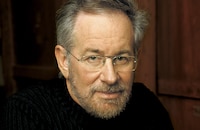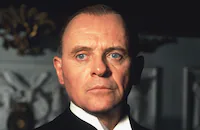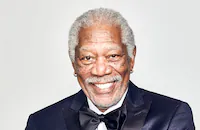Amistad
Brief Synopsis
Cast & Crew
Steven Spielberg
Anthony Hopkins
Morgan Freeman
Matthew Mcconaughey
Anna Paquin
Djimon Hounsou
Film Details
Technical Specs
Synopsis
Based on the true story of the failed mutiny on board the slave ship Amistad in 1839, and the courtroom battle that followed. In the trial that would challenge the very foundation of the American legal system, abolitionist Theodore Joadson, trial lawyer Roger Baldwin and ex-president John Quincy Adams argue for the freedom and civil rights of the captive African slaves.
Director

Steven Spielberg
Cast

Anthony Hopkins

Morgan Freeman

Matthew Mcconaughey
Anna Paquin
Djimon Hounsou
Nigel Hawthorne
Saye Lah
Desere Mondon
Tesfay Yohannes
Jeremy Northam
Paul Guilfoyle
Darren E Burrows
Tim Morrison
Chiwetel Ejiofor
Peter Mansaray
Lansana Sawi
Monguehy Fanzy
Robert V Walsh
Andrew L Josiah
Jim Walker
Castulo Guerra
Tony Owen
Steve Passewe
John Ortiz
Mariah Campbell
Kevin J O'connr
Ingrid Walters
Samuel Orekhio
Ibrahim Sesay
Pete Postlethwaite
George Kamara
Ray Fisher
James Moses
Joseph Kosseh
Sherly Acosta Williams
Hon. Harry A Blackmun
Charles Udoma
George Gerdes

Peter Firth
Omo Lara Tosin
Geno Silva
Charlean Isata Bangalie
Marlon Francis

Austin Pendleton
Gerald R Molen
Yaya Sissoko
Samuel Pieh
El Hadj Malik Sow
Sean Mcguirk
Denver Dowridge
David Paymer
Abdul-fatai Balogun
Xander Berkeley
Leon Singer
Paul Mwakutuya
Prince Coke
Willie Onafesso
Willie Amakye
Andrew Shoemo
Ahmed Bangura
Daniel Reid
Mark Woods
Michael Massee
Amadou Traore
Tomas Milian
Abu Sidique
Curtis Shields
Jeremy Shelton
Bundu Kamara
Clarence Mobley
Rusty Schwimmer
M S Kaleiwo
Bernard Singleton
Ransford Thomas
Rory Burton
Arliss Howard
Harry Groener
Abu Bakaar Fofanah
Razaaq Adoti
Sylvestre Massaquoi
Lester Mombelly
William Young
Chike Okpala
Ralph Brown
Lawal Tajudeen
Michael Riley
Juliette Darko
Pedro Armendßriz
Habib Conteh
Luc Assogba
Jimmy Fotso
Sheriff Kargbo
Edward Appiah
Samson Odede
Allan Rich
Seydou Coulibaly
Victor Rivers
Roosevelt Flenoury
Brian Macon
Adekunle Ilori
Jack Forwalter
Lamine Thiam
Issac Mayanja
Stephen Conteh
Tony Onafesso
Roy Cooper
Baboucar Jobe
Carlos Spivey
Jake Weber
Daniel Von Bargen
Hawthorne James

Stellan Skarsgård
Matt Sarles
Derrick N Ashong
Frank T. Wells
Crew
Richard Abate Jr.
Richard Abate
Dr. Arthur Abraham
Dr. Arthur Abraham
Adelbert Acevedo
Deena Adair
Dr. Todd J Adelman
Karine Albano
Luis Rosario Albert
Jon Alexander
Jim Alfonso
Daniel J Allen
Debbie Allen
Debbie Allen
Michael Altman
Kokayi Ampah
Robert Apisa
James M Arnett
Seth Arnett
Shane Barach
Andrew Barczewski
Denise Barker
Leslie Barnett
Fernando Barraza
Joseph F Barth
Steve Bauerfeind
Anna Behlmer
Mei-ling Belmont
Susan Benjamin
Dr. Lerone Bennett
John Berger
Carlos Bermudez
Nick Bernstein
Chrissie Beveridge
Kelly Birrer
John Blake
Marek Bojsza
Edward H Boyajian
Eric Boyle
David Brace
Rosemary Brandenburg
Jill Brooks
Arnold Brown
Sundai Brown
Christopher Burian-mohr
Gary Burritt
Nelson Bush
Richard Byard
Randy Cabral
John Caglione Jr.
Charles L Campbell
Tony Campenni
John Canavan
Lon Caracappa
Rick Carter
Ronald D Carter
Ruth Carter
Tami Carter
Yolanda Carter
Jamale Case
Kenneth Catando
Ana Cayere
Jake Cerrone
Eric Chambers
John Chaney
Robert Chartier
Robert Chase
Jeffrey A Clark
Peter Clores
Kim Coleman
Bob Collins
Kevin Conlin
Teresa Conners
Laura Connors
Steve Conrow
Caitlin Content
Mary Cook
Andrew Cooper
Bob Cooper
Bill Corso
Patrick Crane
Vic Cuccia
Mike Cuevas
Fred Culbertson
Chris Culliton
Bonnie Curtis
Bernard Dadie
Susan Dangel
Lisa Davis
Chris Daywalt
Sandy De Crescent
Richard Dearmas
Paul Deason
Paul Deason
Greg Dennen
Nancy Deren
Beau Desmond
Maria Devane
David Devlin
Professor Glenda Dickerson
Michael Diieso
Pamela Dillard
Daniel Dirks
Jim Doherty
John Donahue
Michael Douglas
Peter J Dowd
Dean Drabin
Dana Driscoll
Mitch Dubin
Richard Duran
Roch Dutkowiak
Deana Duval
John J Eagan
Michael C. Easter
Don Easy
Jerry M Edemann
Keith Edemann
Louis L Edemann
Ronald Eng
Kevin Erb
John A Escobar
Mark Eshelman
Luis R. Estrella
Kevin Fahey
Sven E M Fahlgren
Mary Fallick
Edward Fanning
Tony Fanning
Carla Farmer
Scott Farrar
Ed Fassl
Leslee Feldman
Michael Fennimore
Frank Ferrara
Sandi Figueroa
Gina Flanagan
Frank Fleming
Alsie L Florence
Frank Foley
Luz Margarita Fonseca
Professor John Hope Franklin
Rick Franklin
David Franzoni
Erica Frauman
John D Frederitz
Jeffrey Frink
Marc Fusco
Matt Galvin
Scott Garrett
Robert Gaskill
Henry Louis Gates
Leonard T Geschke
James Giblin
Cheryl Gibson
Charley H Gilleran
Kelly Gleason
Bill Glesne
Robert Gomula
Rene Gonzalez
Ron Goodman
Dale Grahn
George Grenier
Martin L Grimes
Mark Gustawes
Walt Hadfield
Tina Hamilton
Steven R Hammond
Michael Hancock
Professor Joseph E Harris
Terence Harris
Barbara J Hause
Joseph Hawkins
Angela Heald
Douglas Henri
Sandra Hernandez
Rick Hicks
Sean Hobin
Hilda Hodges
Danielle Hollowell
Gordon Huggins
Doug Jackson
Kevin Lamont Jackson
Robert C Jackson
Askia Won-ling Jacob
Boysie Jereza
Matthew Jerome
Jose Jimenez
Priscilla John
Dr. Clifton Johnson
Joy Johnson
Marci R Johnson
Ed Johnston
Brent L Jones
Eric P Jones
Professor Howard Jones
Kristen Frances Jones
Tom Jordan
Vincente Juarbe
Ronald Judkins
Film Details
Technical Specs
Award Nominations
Best Cinematography
Best Costume Design
Best Score (Dramatic Picture)
Best Supporting Actor
Articles
Amistad
The film begins in the dark, misery-filled hold of the Amistad, a ship carrying kidnapped Africans from Cuba to the American slave market in 1839. One of the prisoners, a tribal leader named Cinque, manages to break out of his chains and lead a revolt against the captain and crew, in which nearly all of the white sailors are killed. Ordered to head toward Africa, where the captives naturally want to return, the surviving crewmen steer the ship northward on the sly, winding up off the coast of Connecticut, where the US Navy moves in and seizes the vessel.
This ends the action-oriented part of Amistad, which now becomes a legal drama with many scenes set in courtrooms and law offices. Connecticut is a non-slavery state, but that doesn't mean it's an anti-slavery state, as the fifty-three captives discover when battles break out among various people claiming ownership of the Amistad's human cargo, up to and including Isabella II, the Spanish queen. A happy ending comes about when former US president John Quincy Adams makes a rousing presentation to the Supreme Court that results in freedom for Cinque and his companions, who have languished behind bars throughout the seemingly interminable ordeal.
The idea of filming the Amistad affair came from actress and director Debbie Allen, who had run across some books on the subject. After running into fund-raising problems, she brought the project to Spielberg, who wanted to stretch his artistic wings after making The Lost World: Jurassic Park (1997), and was looking for a prestige production to direct for DreamWorks SKG, the studio he'd recently co-founded. Spielberg was an unlikely person to tackle the Amistad story, since his previous picture about black characters, The Color Purple, had been badly received by the black community, its eleven Oscar® nominations (no wins) notwithstanding. "I got such a bollocking for The Color Purple," he told a New York Times interviewer, "I thought, I'll never do that again." But he saw great potential in the Amistad story and decided to take it on, even though his crowded schedule meant doing preproduction while DreamWorks was still being launched and postproduction while Saving Private Ryan (1998) was before the camera. Spielberg signed an impressive cast including Anthony Hopkins and Matthew McConaughey, recruited fledgling actor Djimon Hounsou for the key role of Cinque, and assembled a panel of African-American scholars to serve as historical advisors. According to pre-release publicity, he and cinematographer Janusz Kaminski prepared the film's visual style by studying the paintings of Francisco Goya.
Amistad ran into trouble immediately after Spielberg wrapped it, thanks to a legal action filed by the author of a historical novel about the Amistad mutiny. The lawsuit called for damages of $10 million and an injunction barring the film's release, claiming that Spielberg's production company had received a draft of the novel in 1988 and plundered it for "scenes, characters and plot devices," such as the black abolitionist lawyer played by Morgan Freeman, who existed in the novel but not in the real-life Amistad case. The lawsuit sank (after DreamWorks negotiated a monetary settlement) and Amistad sailed into theaters on schedule, but not before the flap generated amusing headlines like Entertainment Weekly's "Mutiny and the Bounty" and Time's "Steven Stealberg?"
Despite its Hollywood stars, dramatic subject, and social conscience, Amistad hit very rough seas when reviewers and audiences got a look at it. Hostile reactions to The Color Purple had left Spielberg with "deep scars," in the words of film scholar Lester D. Friedman, but his second venture into black experience fared even worse, grossing a mere $44 million domestically (compared with $94 million for the earlier film) and a paltry $16.2 worldwide the worst performance of any Spielberg picture to this day, including such legendary let-downs as 1941 (1979) and Always (1989). Among the African-American observers who supported it was critic Armond White, who named it the year's best movie and wrote an essay in Film Comment analyzing and praising it. Among those who derided it was filmmaker Warrington Hudlin, who said that "black people don't want to go to this movie" because only masochists "would want to spend two hours watching themselves be degraded and dehumanized."
White critics were equally divided. "While it's in progress," wrote Stanley Kaufmann in The New Republic, "it envelops us; paradoxically, when it's finished, it seems to stand free, like a strong sculpture." The reviewer for The Washington Post stated that it "again demonstrates the director's flair for bringing lost worlds alive," and Time said that Spielberg "unsentimentally places us in touch with our best sentiments." On the downside, the Rocky Mountain News opined that Amistad's "rendering of history plays like a massive term paper" and Entertainment Weekly described it as "two and a half hours of black men sitting around in chains waiting to be given their freedom." In my Christian Science Monitor review I observed that no African character except Cinque is allowed to present an individual personality, just as most of the Jewish characters in Schindler's List are depicted as an undifferentiated crowd. I also criticized the claim that Goya's "unromanticized realism" had inspired the look of Amistad, since the picture "is drenched so stiflingly in romanticized mistiness that `realism' is one of the last words...to describe it."
Spielberg himself eventually recognized the shortcomings of his ambitious period piece. "I kind of dried it out," he told an interviewer in 1999, "and it became too much of a history lesson." Yet the mixed responses to Amistad when it was new lend it extra interest now, giving viewers a chance to evaluate not only the film but judgments about the film, some of which hold up well while others seem to have missed the point. Spielberg probably won't tackle a specifically black subject again, after the poor showings of Amistad and The Color Purple; but his plan to direct the Civil War epic Lincoln indicates that he's still drawn to the dramatic possibilities of America's racially troubled past.
Producers: Steven Spielberg, Debbie Allen, Colin Wilson
Director: Steven Spielberg
Screenplay: David Franzoni
Cinematographer: Janusz Kaminski
Film Editing: Michael Kahn
Production Design: Rick Carter
Music: John Williams
Cast: Morgan Freeman (Joadson), Nigel Hawthorne (Martin Van Buren), Anthony Hopkins (John Quincy Adams), Djimon Hounsou (Cinque), Matthew McConaughey (Baldwin), David Paymer (Secretary Forsyth), Pete Postlethwaite (Holabird), Stellan Skarsgård (Tappan), Razaaq Adoti (Yamba), Abu Bakaar Fofanah (Fala), Anna Paquin (Queen Isabella), Tomas Milian (Calderon), Chiwetel Ejiofor (Ensign Cobey), Derrick N. Ashong (Buakei), Geno Silva (Ruiz), John Ortiz (Montes), Ralph Brown (Lieutenant Gedney), Darren Burrows (Lieutenant Meade), Allan Rich (Judge Juttson), Paul Guilfoyle (attorney), Peter Firth (Captain Fitzgerald), Xander Berkeley (Hammond), Jeremy Northam (Judge Coglin), Arliss Howard (John C. Calhoun), Austin Pendleton (Professor Gibbs), Kevin J. O'Connor (missionary), Harry A. Blackmun (Associate Justice Joseph Story).
C-152m. Letterboxed. Closed captioning.
by David Sterritt

Amistad
Quotes
Trivia
Miscellaneous Notes
Winner of the 1998 European Film Award for European Achievement in World Cinema (Stellan Skarsgard).
Janusz Kaminski was nominated in the feature film category for the 1997 Outstanding Achievement Awards sponsored by the American Society of Cinematographers.
Nominated for the 1997 Golden Laurel award (Steven Spielberg, Debbie Allen and Colin Wilson) by the Producers Guild of America.
Nominated for two 1997 NAACP Image Awards, including Best Picture and Best Actor (Djimon Hounsou).
Steven Spielberg was nominated for Outstanding Directorial Achievement in 1997 by the Directors Guild of America.
Released in United States Winter December 10, 1997
Limited Release in United States December 12, 1997
Wide Release in United States December 25, 1997
Released in United States on Video June 30, 1998
Released in United States 1998
Released in United States January 1998
Released in United States February 1998
Released in United States December 1998
Shown at American Film Market (AFM) in Santa Monica, California February 26 - March 6, 1998.
Shown at Brussels International Film Festival January 20-31, 1998.
Shown at Olso Film Days in Oslo, Norway February 6-12, 1998.
Shown at Havana Film Festival in Havana, Cuba December 1-11, 1998.
Attornies for novelist Barbara Chase-Riboud filed a $10,000,000 suit against the makers of "Amistad" in an attempt to block its release. They claimed that the filmmakers plagiarized her work "Echo of Lions." The suit was subsequently dropped after DreamWorks suggested that "Echo of Lions" actually plagiarized sections of the book "Black Mutiny."
Screenwriter David Franzoni was previously hired by Dustin Hoffman's Punch Productions to adapt Barbara Chase-Riboud's "Echo of Lions" for a film that was to star Dustin Hoffman as John Quincy Adams and to be directed by Barry Levinson.
Completed shooting April 30, 1997.
Began shooting February 18, 1997.
Steven Zaillian contributed to a draft of the screenplay, but after WGA arbitration did not receive screen credit.
Released in United States Winter December 10, 1997
Limited Release in United States December 12, 1997
Wide Release in United States December 25, 1997
Released in United States on Video June 30, 1998
Released in United States 1998 (Shown at American Film Market (AFM) in Santa Monica, California February 26 - March 6, 1998.)
Released in United States January 1998 (Shown at Brussels International Film Festival January 20-31, 1998.)
Released in United States February 1998 (Shown at Olso Film Days in Oslo, Norway February 6-12, 1998.)
Released in United States December 1998 (Shown at Havana Film Festival in Havana, Cuba December 1-11, 1998.)














